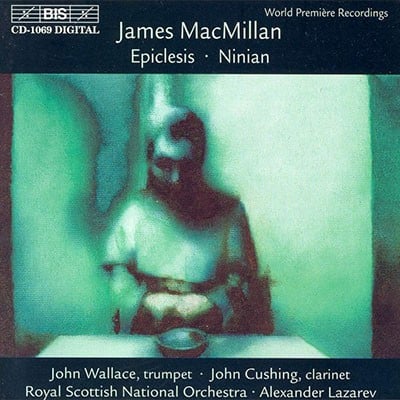3(III=picc).2.corA.3(III=bcl).2.dbn-6.3.3.1-timp.perc(4):marimba/
thundersheet/bowl gong/2tam-t(lg & sm, with bows)/4gamelan
gongs/2vib(bowed)/crot/sanctus bells/4cowbells/6tom-t/2bongos/glsp/
cyms/anvil/cencerros(chromatic cowbells)/t.bells/BD/bell tree/4wdbl/
tgl/SD-strings(min.14.12.10.8.8)
offstage: 2 antiphonal tpt
Abbreviations (PDF)
Boosey & Hawkes
Epiclesis is a concerto for trumpet and large orchestra in one movement lasting about 20 minutes. The word Epiclesis means an invocation calling upon God’s name during any blessing or consecration. It is mostly used with specific reference to the invocation during the Eucharistic Celebration in which the gifts of bread and wine are consecrated into the Body and Blood of Christ. In this case the power of the Holy Spirit is invoked to bring about transubstantiation.
The concerto is a musical meditation on the mystery of the Eucharist and the idea of transformation of materials. There are two main musical ‘substances’ forming the argument and formal development of the piece. Throughout the work one material influences and invades the other and vice versa, so that one music ‘becomes’ the other.
Epiclesis begins unexpectedly as if from nowhere. A mysterious, hazy-textured introduction is interrupted suddenly and violently by a short ecstatic interjection on wind and percussion. This is followed by a lengthy exposition Adoro te devote. The fast violent music and the slow, Gregorian-based music proceed in a series of stark juxtapositions, one becoming longer and more developed at each appearance, the other contracting at each appearance.
Eventually one musical material becomes transformed into a version of the other. The central climax involves the full flowering of the Gregorian theme in the context of the fast unsettled music. This is followed by a recitativo accompagnato, in which the soloist invokes violent, surging responses from the orchestra. After these convulsions, in a moment of uneasy calm we hear the Adoro te devote played on bowed vibraphones and double bass harmonics. The process has worked itself through; the transformation of musical substances is complete.
This is followed by a fast ecstatic dance – a rhythmic celebration in which the soloist now plays piccolo trumpet. The theatrical symbolism at the end of the work is meant to signify the living God, unseen by yet perceived, and is meant to reflect the words of St Thomas Aquinas (here translated by Gerard Manley Hopkins).
Adoro te devote, latens Deitas,
Quae sub his figuris vere latitas
Tibi se cor meum totum subjicit,
Quia, te contemplans, totum deficit.
Godhead here in hiding, whom I do adore,
Masked by these bare shadows, shape and nothing more
See, Lord, at thy service low lies here a heart
Lost, all lost in wonder at the God thou art.
James MacMillan
Reproduction Rights
This programme note can be reproduced free of charge in concert programmes with a credit to the composer
"...MacMillan writes brilliantly for brass. The trumpet is not used as a bravura expressionist, more as a virtuoso communicator. The writing has a jazz-like conversational flow..."
The Scotsman

John Wallace, trumpet/Royal Scottish National Orchestra/Alexander Lazarev
BIS CD 1069

